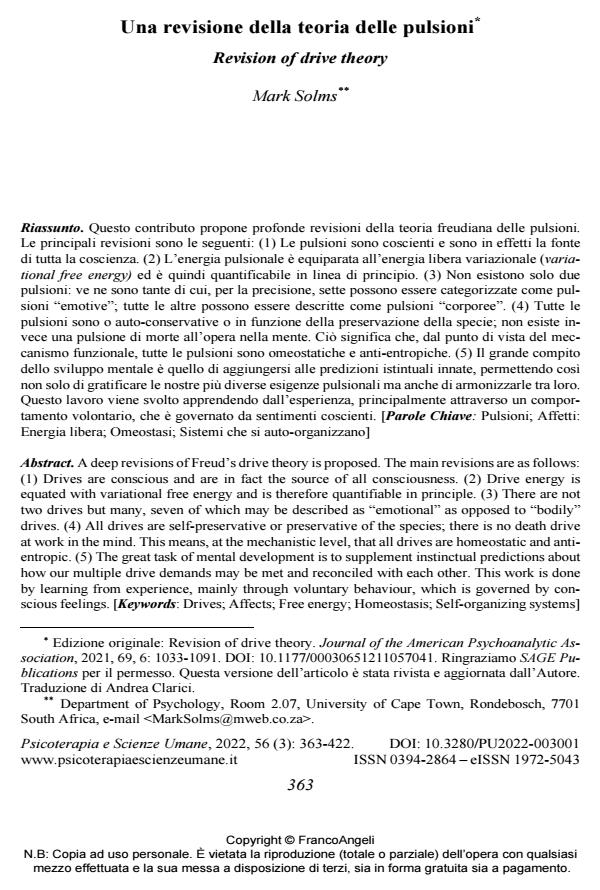Una revisione della teoria delle pulsioni
Titolo Rivista PSICOTERAPIA E SCIENZE UMANE
Autori/Curatori Mark Solms
Anno di pubblicazione 2022 Fascicolo 2022/3
Lingua Italiano Numero pagine 60 P. 363-422 Dimensione file 382 KB
DOI 10.3280/PU2022-003001
Il DOI è il codice a barre della proprietà intellettuale: per saperne di più
clicca qui
Qui sotto puoi vedere in anteprima la prima pagina di questo articolo.
Se questo articolo ti interessa, lo puoi acquistare (e scaricare in formato pdf) seguendo le facili indicazioni per acquistare il download credit. Acquista Download Credits per scaricare questo Articolo in formato PDF

FrancoAngeli è membro della Publishers International Linking Association, Inc (PILA)associazione indipendente e non profit per facilitare (attraverso i servizi tecnologici implementati da CrossRef.org) l’accesso degli studiosi ai contenuti digitali nelle pubblicazioni professionali e scientifiche
Questo contributo propone profonde revisioni della teoria freudiana delle pulsioni. Le principali revisioni sono le seguenti: (1) Le pulsioni sono coscienti e sono in effetti la fonte di tutta la co-scienza. (2) L’energia pulsionale è equiparata all’energia libera variazionale (variational free energy) ed è quindi quantificabile in linea di principio. (3) Non esistono solo due pulsioni: ve ne sono tante di cui, per la precisione, sette possono essere categorizzate come pulsioni "emotive"; tutte le altre possono essere descritte come pulsioni "corporee". (4) Tutte le pulsioni sono o auto-conservative o in funzione della preservazione della specie; non esiste invece una pulsione di mor-te all’opera nella mente. Ciò significa che, dal punto di vista del meccanismo funzionale, tutte le pulsioni sono omeostatiche e anti-entropiche. (5) Il grande compito dello sviluppo mentale è quel-lo di aggiungersi alle predizioni istintuali innate, permettendo così non solo di gratificare le nostre più diverse esigenze pulsionali ma anche di armonizzarle tra loro. Questo lavoro viene svolto apprendendo dall’esperienza, principalmente attraverso un comportamento volontario, che è gover-nato da sentimenti coscienti.
Parole chiave:Pulsioni; Affetti: Energia libera; Omeostasi; Sistemi che si auto-organizzano
- Editoriale Laura Corbelli, Paolo Migone, in Ricerca Psicoanalitica /2022
DOI: 10.4081/rp.2022.726
Mark Solms, Una revisione della teoria delle pulsioni in "PSICOTERAPIA E SCIENZE UMANE" 3/2022, pp 363-422, DOI: 10.3280/PU2022-003001